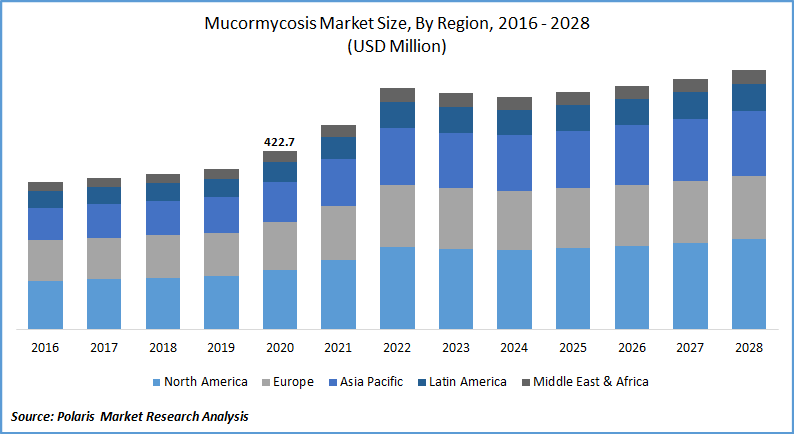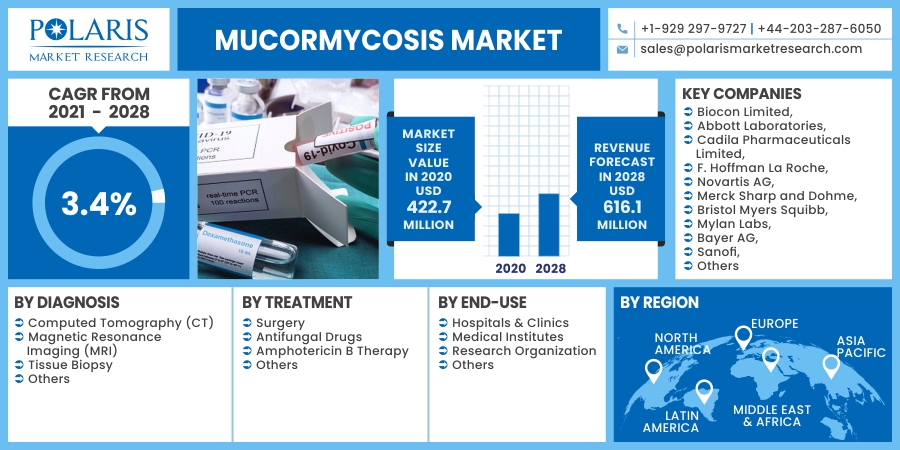
Mucormycosis Market Share, Size, Trends, Industry Analysis Report; By Diagnosis (Computed Tomography, MRI, Tissue Biopsy); By Treatment (Surgery, Antifungal Drugs, Amphotericin B Therapy, Others); By End-Use; By Region; Segment Forecast, 2021 - 2028
- Published Date:May-2021
- Pages: 117
- Format: PDF
- Report ID: PM1905
- Base Year: 2020
- Historical Data: 2016 - 2019
Report Outlook
The global mucormycosis market was valued at USD 422.7 million in 2020 and is expected to grow at a CAGR of 3.4% during the forecast period. The upsurge in the prevalence of fungal infections, the availability of an extensive variety of drugs, the rising incidence of immunological diseases, and the emergence of coronavirus are some of the factors driving the market growth. Furthermore, rising public awareness of fungal infection and increased government funding for research and development has further fueled the market growth.
 Know more about this report: request for sample pages
Know more about this report: request for sample pages
The global mucormycosis market will be mainly driven by the emergence of the COVID-19 pandemic during the forecast period. Other factors that may contribute to the growth of the market include a rapid rise in hematological cancers and bone marrow transplants.
The emergence of the COVID-19 pandemic has increased the risk of developing mucormycosis. Before the pandemic, this fungal infection was rare, and the global incidence was just only 0.06 per 10,000 people every year. COVID-19 is causing huge healthcare challenges across the globe. COVID-19 was detected in more than 155 million global people as of May 2021. US, India, and Brazil are the worst affected countries due to the pandemic.
In the U.S. alone, more than 33 million people are affected by the disease till now. India is facing the worst second wave where 4, 00,000 cases are detected every day which is the highest number of cases for any country from the beginning of the pandemic. The increasing cases of COVID-19 will significantly increase the number of mucormycosis cases across the global market.
Industry Dynamics
Growth Drivers
The pandemic has an increased risk of mucormycosis as COVID-19 patients are immune-compromised by the use of certain drugs used in viral treatment. Typically, steroids and other antiviral drugs are used in the treatment which will significantly impact the immune system of the patient. Steroid treatment will also increase the blood glucose levels in corona patients which will make them more susceptible to mucormycosis.
Some of the hospitals in India are treating 200 mucormycosis patients and some of the regions in the Indian state of Maharashtra have seen a 100%-200% rise in mucormycosis cases during the second wave of the pandemic in the market.
Mucormycosis will lead to blindness, organ dysfunctions, and other problems which may sometimes require surgical treatments. The exponential increase in cases of COVID-19 associated with mucormycosis in certain parts of the world will be the main factor for the growth of the global market during the forecast period.
The other important market factors that will contribute to the global mucormycosis market include an increase in organ and bone marrow transplantation along with growing hematological cancer cases and diabetic patients since these people will have a weak immune system.
Globally an approximated 0.45 million people are diagnosed with leukemia every year. Currently, 463 million diabetic people are living worldwide, and the numbers are expected to reach 578 million, by 2030. Hence the chances of people developing fungal infection will also increase in the coming years.
New drugs and diagnostic procedures are being introduced for the treatment and diagnosis of the infection. In September 2019, U.S. FDA granted Fast Track designations for intravenous (IV) and oral formulations for fosmanogepix (APX001) developed, by Amplyx Pharmaceuticals.
It is approved the treatment of seven indications that include mucormycosis. Pfizer Inc. in association with its partner Basilea Pharmaceutica Ltd launched Cresemba (isavuconazole) in Taiwan, in 2020. The drug is used in mucormycosis and invasive aspergillosis.

Know more about this report: request for sample pages
Mucormycosis Market Research Scope
The market is primarily segmented on the basis of diagnosis, treatment, end-use, and region.
|
By Diagnosis |
By Treatment |
By End-Use |
By Region |
|
|
|
|
Know more about this report: request for sample pages
Insight By Treatment
The market on the basis of treatment is segmented into antifungal drugs, amphotericin therapy, and others. The antifungal drugs market segment is further categorized into Posaconazole, Fluconazole, Isavuconazole, Voriconazole, Flucytosine, and Others.
Antifungal drugs and amphotericin B therapy are mostly used for the treatment. The only approved antifungal therapy for mucormycosis is amphotericin B (AMB) preparations, of which liposomal AMB (L-AMB) is commonly used in Europe as the standard of treatment.
Geographic Overview
North America is expected to be the biggest market for mucormycosis owing to the increase in COVID-19 cases along with an increase in the cases of diabetic people and hematological cancer. Nearly, 35 million people are affected by diabetes and approximately 1,78,000 people were diagnosed with hematological cancer. The improved healthcare has led to many transplantation procedures and nearly 5,000 bone marrow transplantations are conducted in the U.S. every year.
Asia Pacific is expected to be the fastest-growing market during the forecast period. The increasing case of COVID-19 has resulted in an unprecedented increase in the cases of mucormycosis in countries like India. The cases of HIV are also more in the Southeast Asian region and India with 2.1 million people is the third-worst HIV-affected country in the globe.
Competitive Insight
Companies are focusing to develop new drugs and methods to diagnose mucormycosis owing to the emergence of the COVID-19 pandemic. Major market players are entering into partnerships and collaborations for the distribution of their drugs globally.
Some of the major market players operating in the market for mucormycosis include Biocon Limited, Abbott Laboratories, Cadila Pharmaceuticals Limited, F. Hoffman La Roche, Novartis AG, Merck Sharp and Dohme, Bristol Myers Squibb, Mylan Labs, Bayer AG, Sanofi, Lonza Group, Johnson & Johnson, Gilead Sciences and Pfizer Inc.
